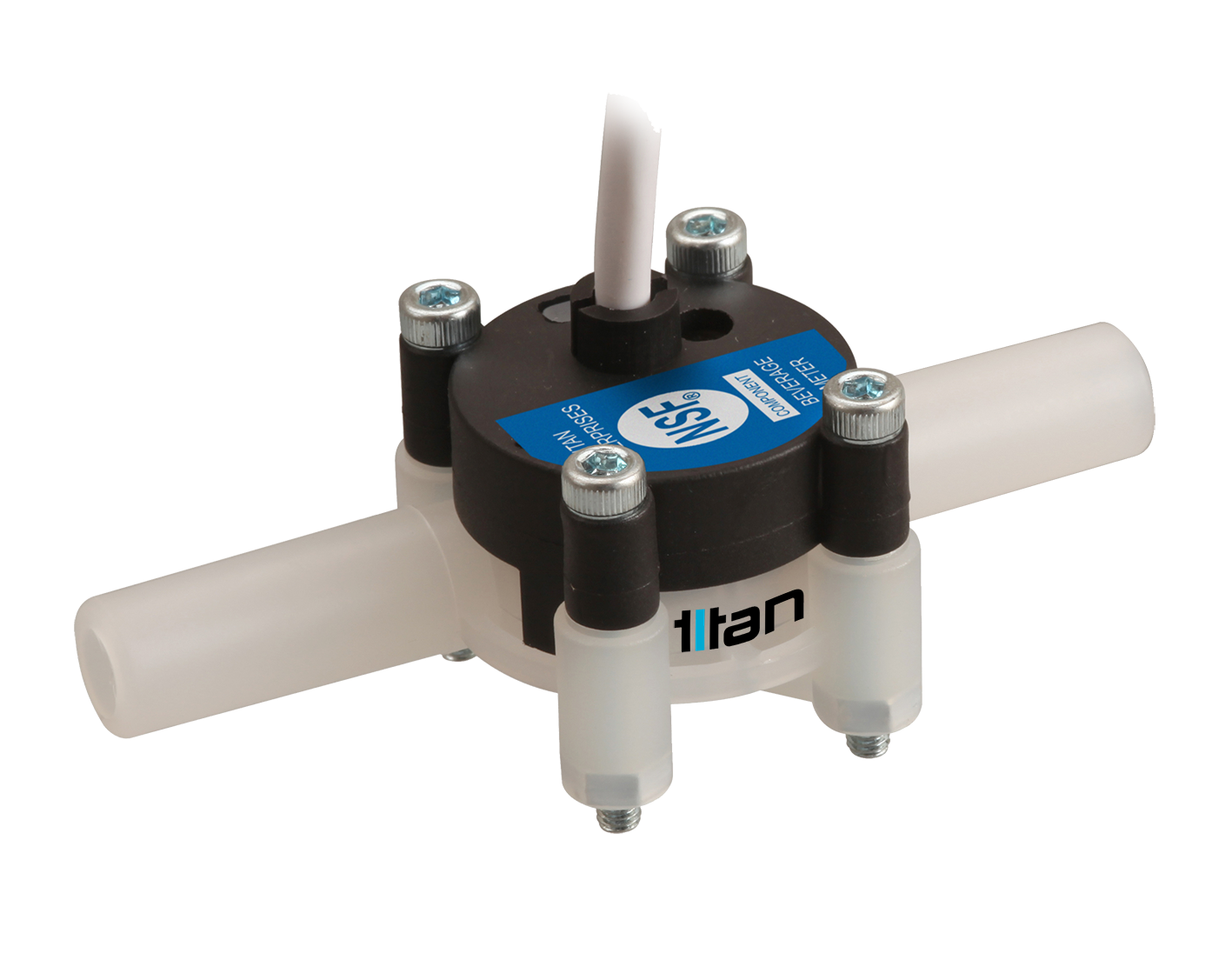When it comes to beverage dispensing and flow measurement, Titan Enterprises offers two distinct solutions: the well-established Beverage Turbine Meter and the newly released Ultrasonic Beverage Meter. Each has unique strengths and trade-offs, making the choice application-dependent.
Here we define the differences between the technologies used within each Beverage flow meter:
Measurement Technology
- Turbine Meter: Operates on a mechanical principle using a Pelton wheel turbine and sapphire bearings. This design provides consistent repeatability and has 1.5% Full Scale Accuracy but introduces moving parts into the system.
- Ultrasonic Meter: Uses the ‘time of flight’ principle to measure flow, with no moving parts. This eliminates mechanical wear and contamination risk, while offering a completely clean, straight bore, and accuracy better than 2% of reading.
Materials & Design
- Turbine Meter: Constructed from PVDF with sapphire bearings and Viton™ seals, it is robust and resistant to a wide temperature range. This device is NSF-approved under the NSF standard 169 as ‘Special Purpose Food Equipment and Devices’.
- Ultrasonic Meter: Built from food approved ABS/PC polymer with Viton™ seals, offering a lightweight design with a straight 6 mm bore. The absence of internal obstructions makes it easy to clean using sponge balls. All parts are to FDA / EU food approved standards and NSF-approval will be sought for this product when it reaches full commercialisation.
Performance
- Granularity:
- Beverage Turbine: 1400 pulses per litre (lower resolution).
- Ultrasonic Beverage: 5000 pulses per litre (higher resolution).
- Flow Range:
- Beverage Turbine: 0.6–10 l/min – limited low-end capability.
- Ultrasonic Beverage: 0.2–10 l/min – better for low flow applications.
- Linearity & Repeatability:
- Beverage Turbine: ±1.0% FSD linearity, excellent ±0.1% repeatability.
- Ultrasonic Beverage: ±2% of reading linearity, ±0.5% repeatability.
- Temperature Range:
- Beverage Turbine: 0–125 °C, suitable for hot and cold beverages.
- Ultrasonic Beverage: 3–15 °C, restricted primarily to chilled beverages.
Installation & Operation
- Both beverage meters use John Guest 3/8” push-fit connections, ensuring compatibility with standard tubing.
- Pressure drop is minimized in both designs, though the ultrasonic’s straight 6mm bore gives it a lower overall pressure drop.
- Power requirements differ slightly: the beverage turbine meter runs from 5–24 VDC, whereas the ultrasonic models require 7–24 VDC.
- Both types are calibrated in-situ by the customer to suit the system requirements.
- No moving parts within the ultrasonic beverage meter eliminates any contamination issues and allows the use of sponge balls to clean.
Cost Considerations
- Beverage Turbine: Budget-friendly and reliable, particularly for high-temperature or mixed-use applications.
- Ultrasonic Beverage: Nearly five times the cost, but justifiable for hygienic, low-maintenance, and high-resolution needs.
Unique Selling Points
- Beverage Turbine: A low-cost, robust, highly repeatable flowmeter, and capable of handling hot beverages.
- Ultrasonic Beverage Meter: Hygienic design with no moving parts, higher resolution, factory-settable K factor, potential for both NPN and PNP outputs, and easy cleaning. Good linearity enables effective use of the device in variable flow rates.
Disadvantages
- Beverage Turbine: Moving parts within the meter require cleaning and can cause blockages if not maintained.
- Ultrasonic Beverage: Narrow temperature range limits use to cold beverages; higher upfront cost.
Comparison Verdict
For beverage systems where cost-efficiency, high repeatability, and wide temperature tolerance are priorities, the Beverage Turbine Meter remains a solid choice. However, in applications demanding hygiene, easy cleaning, low-flow measurement, and long-term reliability with no moving parts, the new Ultrasonic Beverage Meter justifies its premium price.
The ultrasonic beverage meter is more accurate over the flow range, so ideal for monitoring systems with variable flow. It was also designed to allow cleaning with sponge balls in a beer dispense hose and pipe system.
Ultimately, the decision comes down to whether you value economy and temperature versatility (Turbine) or hygienic design and precision at low flows (Ultrasonic).
For the full technical data of each beverage meter, visit their website. For more information on Titan Enterprises and its flow meter solutions for the food and beverage industry, contact Titan Enterprises via email sales@flowmeters.co.uk.







